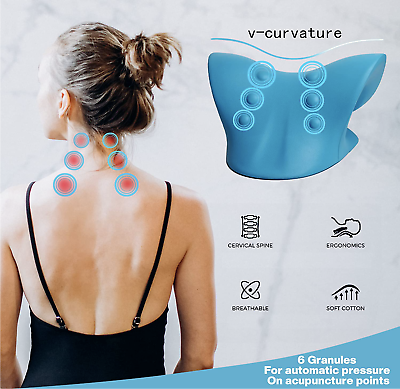How the Neck Cloud Can Aid With Persistent Neck Pain and Rigidity
How the Neck Cloud Can Aid With Persistent Neck Pain and Rigidity
Blog Article
Neck Pain in the Office: Identifying Risk Factors and Implementing Ergonomic Solutions
Neck pain in the workplace is a prevalent concern that can affect worker health and productivity. By understanding the numerous threat elements adding to neck pain and applying ergonomic services, organizations can create a more helpful work atmosphere.
Usual Reasons For Neck Discomfort
Neck pain in the workplace is a prevalent issue that can be connected to several common causes. In addition, recurring motions such as constant flexing, twisting, or getting to can additionally add to neck pain over time.

Ergonomic Risk Aspects
Poor ergonomics in the office can dramatically add to neck pain amongst employees. Aspects such as inappropriate desk height, insufficient chair assistance, and unpleasant positioning of computer monitors can all play a function in the growth of neck discomfort. When employees are compelled to sit for extended durations ready that strain their neck muscular tissues, it can lead to stiffness, pain, and much more serious bone and joint issues over time.
Additionally, poor ergonomic techniques can result in workers adopting uncomfortable stances while functioning, such as craning their necks to see a computer display or reaching annoyingly for a mouse or keyboard. neck cloud. These abnormal positions and recurring activities can put undue anxiety on the neck and bordering muscular tissues, leading to pain and reduced productivity

Workdesk Arrangement Recommendations
When establishing up a workdesk in the work environment, it is necessary to take note of the functional designs of the environment. To decrease the threat of neck discomfort and discomfort, there are numerous desk configuration recommendations that staff members must think about. Firstly, guarantee that the computer monitor is positioned at eye level to avoid stressing the neck by looking up or down. The keyboard and mouse must be placed at an elevation where the elbows are curved at a 90-degree angle to promote appropriate wrist alignment. In addition, the chair height must allow the feet to relax level on the floor with thighs alongside the ground.
It is likewise vital to have adequate lighting to minimize eye strain, as scrunching up your eyes or leaning forward can cause neck stress. Organize the desk format to maintain regularly used products within arm's reach, restricting the need for recurring twisting or reaching motions. By carrying out these desk configuration suggestions, employees can develop a more ergonomic workspace that sustains neck health and check that reduces the risk of creating occupational neck discomfort.
Stretching and Exercise Tips
To preserve adaptability and reduce muscle mass tension in the work environment, incorporating extending and exercise routines can be advantageous for general health and efficiency. Straightforward desk-friendly stretches can help ease neck pain and protect against rigidity. Neck rolls, shoulder shrugs, and gentle side-to-side neck stretches work in alleviating tension. In addition, incorporating exercises like chin tucks, shoulder blade presses, and top back stretches can assist reinforce muscles that sustain good pose.
Setting tips or utilizing apps that prompt motion can help develop a routine extending routine. By prioritizing these activities, you can enhance your physical health, lower the danger of neck pain, and improve your total productivity in the office.
Value of Regular Breaks
In a busy work atmosphere where demands can add to physical stress like neck pain, establishing a regimen that stresses the value of routine breaks is extremely important (neck cloud). Taking regular breaks throughout the day is crucial for preventing and easing neck pain. Prolonged durations of resting or repetitive tasks can lead to muscular tissue stress and tightness in the neck and shoulders. By incorporating short breaks right into the work regular, workers can decrease the risk of establishing neck discomfort and improve general comfort and efficiency.
Normal breaks permit staff members to relax their muscles, stretch, and turn, protecting against stiffness and promoting much better flow. Encouraging staff members to take short breaks every 30-60 mins can aid decrease the build-up of look at these guys stress in the neck and shoulders. These breaks can likewise act as a possibility for employees to practice leisure techniques or mild neck stretches, even more advertising bone and joint health and wellness. Carrying out a culture that values and prioritizes routine breaks can have a significant influence on lowering neck pain and enhancing total well-being in the office.
Final Thought
Finally, resolving ergonomic danger factors and applying correct workstation setups are crucial in lowering neck pain in the office. By promoting good posture, providing ample assistance, and motivating regular breaks and stretches, Clicking Here organizations can create a healthier and a lot more productive work atmosphere for employees. Focusing on employee wellness via ergonomic remedies is essential to avoiding pain and boosting general work environment contentment.
Neck pain in the work environment is a widespread problem that can impact employee health and performance. By determining and attending to these common reasons of neck pain in the work environment, companies can take aggressive actions to develop a much more comfortable and ergonomic job atmosphere for their employees.
Poor functional designs in the office can considerably contribute to neck discomfort among workers. By executing these workdesk configuration recommendations, workers can produce a much more ergonomic workspace that supports neck health and minimizes the danger of developing work-related neck pain.
Neck rolls, shoulder shrugs, and gentle side-to-side neck stretches are efficient in alleviating tension.
Report this page